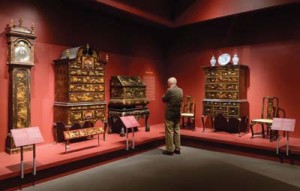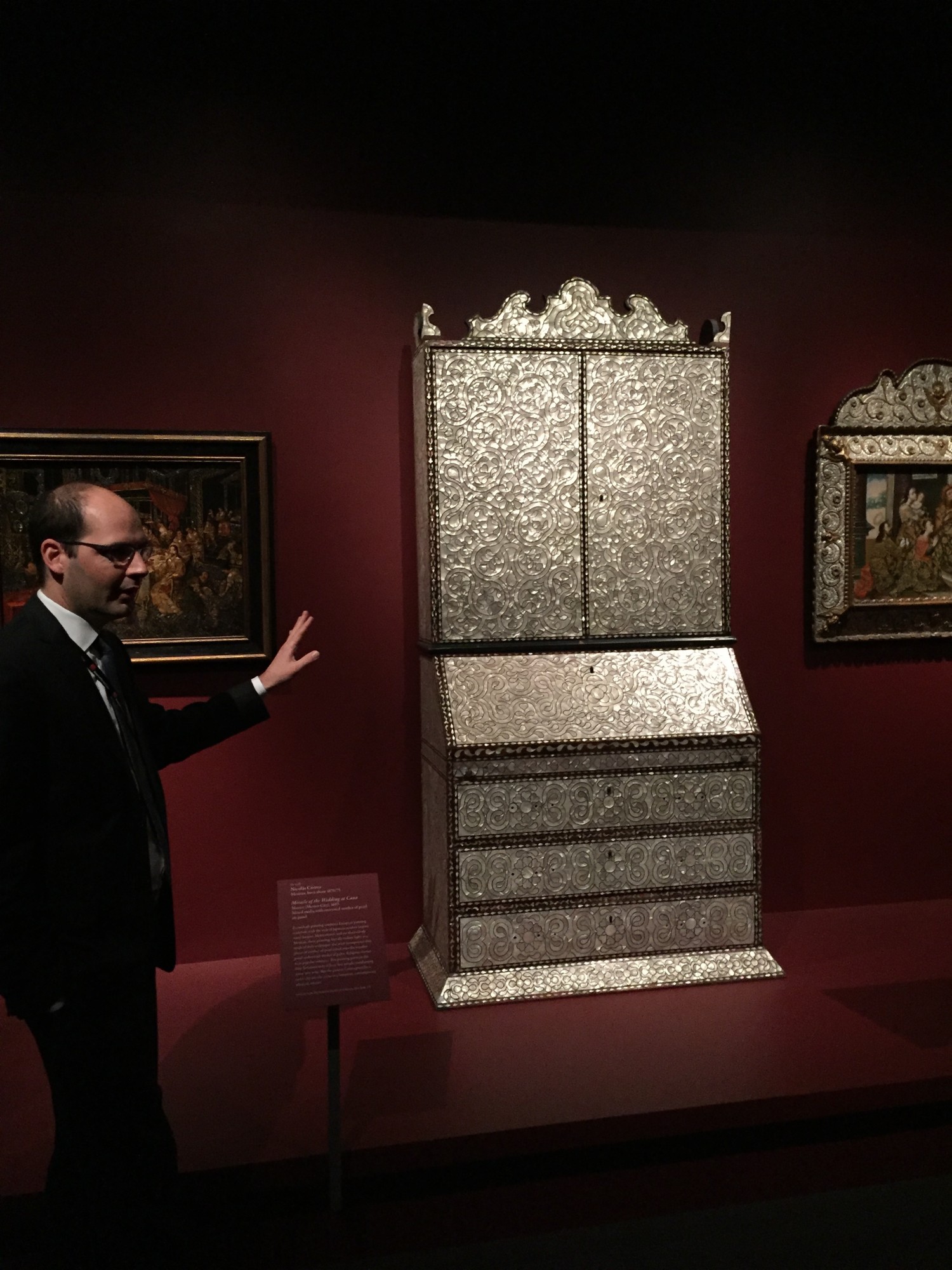Made in the Americas: The New World Discovers Asia
EXHIBITION REVIEW
By Christian Roden
Of the many eye-catching objects on display in “Made in the Americas: The New World Discovers Asia,” at the Museum of Fine Arts Boston, one that commands particular attention is a large desk and bookcase, completely covered in mother-of-pearl inlay. As the show’s curator, Trust member Dennis Carr, the Carolyn and Peter Lynch Curator of American Decorative Arts and Sculpture, told the participants in December 5th’s behind-the-scenes tour, such pieces are a dead ringer for ones made in Goa, India. This piece was sold to Doris Duke as such, and for several decades had stayed little noticed in her bedroom in Newport, RI. Not only did tests of the wood during Carr’s research for the show prove the case to be made of wood native to the area of Lima, Peru, but the interior of one of the drawers revealed a practice attempt at tracing the design for the intricate shell inlay. Remarkably, this piece was not only designed and made in the New World, it was finished to a degree that rivaled the foreign competition.
The introduction of European decorative arts forms and fashionable taste in the New World, as Dennis emphasized, stretched back much further than most Americans realize. Decades before the Pilgrims landed in Plymouth, the Spanish Empire had established massive cities of more than 100,000 inhabitants in South America. These urban centers processed the natural resources of hardwoods and precious metals and established vibrant craft workshops that produced goods inspired by imported luxury items from the Far East, primarily China and Japan.
Although the exhibit space at the MFA Boston is intimate in scale, the show’s design expertly unfolds a history of trade during the initial period of economic and diplomatic relations between the Far East and the New World, despite Japan’s famous refusal of European merchants and missionaries for two centuries beginning in 1633. The majority of the show covers artisans’ adoption of the exotic materials and motifs from Asia into their own work.
In addition to the Incan-produced textiles, feather fans, and vibrantly painted and inlayed furniture from South America, decorative arts enthusiasts will find many favorite North American examples, including Boston-made japanned furniture, rococo furniture in the chinoiserie style, and lead-glazed earthenware in blue-and-white patterns (although the indigenous potters of Mexico occasionally conflated the Chinese cranes with their native symbol of an eagle alighting on a cactus). Many of the pieces, some on loan from South America by descendants of their original owners, are on public view for the first time.
Member benefit tours such as these are one of the new types of programs introduced in 2015. We’re grateful for Dennis’s time providing two fantastic back-to-back tours, and were delighted to see so many familiar faces and welcome a few first-time participants as well. We will continue to develop similar programs in 2016!
Made in the Americas: The New World Discovers Asia closes on February 15, 2016, and will then travel to the Winterthur Museum, Garden & Library, where it will be on view from March 26 through the end of the year.
SAVE THE DATE
- Fall Symposium 2016
Virginia’s Lower Shenandoah and Upper Potomac River Valleys
October 20-23, 2016 - Spring Study Trip Abroad
Scotland
May 14-22, 2017 - Fall Study Trip Abroad
Venice and the Veneto
Fall, 2017
By Christian Roden
Of the many eye-catching objects on display in “Made in the Americas: The New World Discovers Asia,” at the Museum of Fine Arts Boston, one that commands particular attention is a large desk and bookcase, completely covered in mother-of-pearl inlay. As the show’s curator, Trust member Dennis Carr, the Carolyn and Peter Lynch Curator of American Decorative Arts and Sculpture, told the participants in December 5th’s behind-the-scenes tour, such pieces are a dead ringer for ones made in Goa, India. This piece was sold to Doris Duke as such, and for several decades had stayed little noticed in her bedroom in Newport, RI. Not only did tests of the wood during Carr’s research for the show prove the case to be made of wood native to the area of Lima, Peru, but the interior of one of the drawers revealed a practice attempt at tracing the design for the intricate shell inlay. Remarkably, this piece was not only designed and made in the New World, it was finished to a degree that rivaled the foreign competition.
The introduction of European decorative arts forms and fashionable taste in the New World, as Dennis emphasized, stretched back much further than most Americans realize. Decades before the Pilgrims landed in Plymouth, the Spanish Empire had established massive cities of more than 100,000 inhabitants in South America. These urban centers processed the natural resources of hardwoods and precious metals and established vibrant craft workshops that produced goods inspired by imported luxury items from the Far East, primarily China and Japan.
Although the exhibit space at the MFA Boston is intimate in scale, the show’s design expertly unfolds a history of trade during the initial period of economic and diplomatic relations between the Far East and the New World, despite Japan’s famous refusal of European merchants and missionaries for two centuries beginning in 1633. The majority of the show covers artisans’ adoption of the exotic materials and motifs from Asia into their own work.
In addition to the Incan-produced textiles, feather fans, and vibrantly painted and inlayed furniture from South America, decorative arts enthusiasts will find many favorite North American examples, including Boston-made japanned furniture, rococo furniture in the chinoiserie style, and lead-glazed earthenware in blue-and-white patterns (although the indigenous potters of Mexico occasionally conflated the Chinese cranes with their native symbol of an eagle alighting on a cactus). Many of the pieces, some on loan from South America by descendants of their original owners, are on public view for the first time.
Member benefit tours such as these are one of the new types of programs introduced in 2015. We’re grateful for Dennis’s time providing two fantastic back-to-back tours, and were delighted to see so many familiar faces and welcome a few first-time participants as well. We will continue to develop similar programs in 2016!
Made in the Americas: The New World Discovers Asia closes on February 15, 2016, and will then travel to the Winterthur Museum, Garden & Library, where it will be on view from March 26 through the end of the year.


